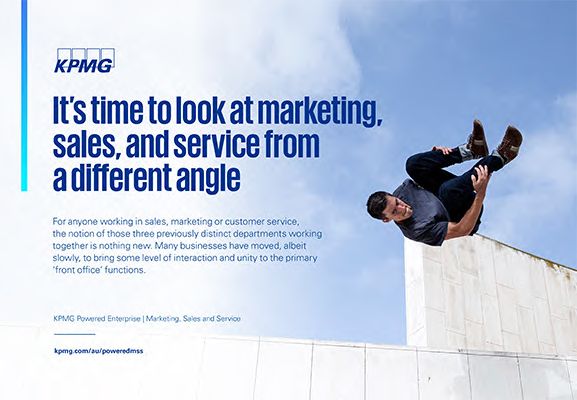Today’s discerning, digitally savvy customer expects to be valued, understood and engaged by a streamlined, frictionless experience.
Tomorrow’s customer will likely expect even more, as technologies develop at lightning speed and influence consumer choice.
Yet while many organisations are committed to embracing change for the customer, process silos, system silos and information silos may hold them back. Perfecting the customer experience can only be achieved when people and processes are aligned with a customer-centric strategy.
So where to start?

Look at marketing, sales and service from a different angle
Bring a new level of interaction and unity to the front office.
Download ebook ❯
Well-integrated front office functions break down silos
For most companies, the customer experience at any point in time is the cumulative outcome of multiple different experiences that are often siloed within customer functions – a marketer, a sales representative, and service technician. Or alternatively through multiple channels, such as in store, on the web, or through a channel partner. As a result, the customer experience is the default outcome of siloed systems, processes and structures.
Leading, innovative companies understand, in order to deliver excellent customer experience across all channels, a frictionless front office function – made up of marketing, sales and service capabilities – is required. Their processes are carefully orchestrated, end-to-end, across the customer journey. The companies that truly satisfy the customer, are those that build their experiences from the customer back, bringing functions and channels together to support the customer needs, first and foremost.
There is, therefore, a demonstrable and pressing need for leaders to develop marketing, sales and service functions that work smarter together, to help ensure a more unified journey for your customer. This transformation to a converged front office may sound daunting but it is crucial.
We outline practical tactics – touching on mindset, strategy, process and technology – that will help your company breakdown silos and achieve transformational success.
Cross-functional delivery is key to greater customer satisfaction
The first step to creating the converged front office, with the customer at the heart, is to have people work together across silos with a deep understanding of the customer.
There is a growing appreciation of the benefits of cross-functional delivery, and with customers demanding support and fulfillment from every angle, it’s the perfect time to make the most of this groundswell to lead and foster collaboration from strategists, process guardians, channel and product owners and operational leaders.
Organisations should move past the days of working behind closed doors within a siloed process where outcomes were narrowed down to siloed goals. Businesses should build synergised teams, that are instilled with shared customer-centric objectives, mutual customer understanding, new collaborative ways of working designed to help develop and deliver relevant and differentiated customer experiences.
As a result of this cross-pollination and cohesion of process, your customer should no longer encounter a disjointed set of different interactions at their touchpoints with your business – their experience should be an intentional one where it feels more relevant, easier, and personalised.
Highlighting customer needs as part of your firmwide strategy
Bringing your teams and channels together by breaking down siloed functions, processes and goals can be challenging. Nevertheless, the journey to a more unified business unit can be transformational for the broader team and customer. But it’s unlikely to happen overnight.
To succeed in this approach, leaders should, as a priority, lead from the front and show that collaboration is the key to success. Further, senior executives should set a company-wide customer experience strategy that reflects the organisation’s purpose and how it connects with the customer. Leaders should demonstrate that they too are purpose-driven with the customer at their core; it’s about being authentic, empathetic, and have understanding. This can give teams the tools and skills to succeed as well as asking the right questions and listening to the answers. Not only can this improve your team’s delivery, but this emotionally intelligent and skills-aware approach can also manifest itself with your customer – which they will likely appreciate.
While breaking down silos can encourage cross-functional working that supports the customer, an additional tool for transformation is the reimagination of the C-suite. The front office functions that are working more closely together may also benefit from shared leadership or at a minimum shared goals and objectives.
Prevalent examples of more converged office accountability can be seen with the development of Chief Customer Officers, Chief Experience Officers and Chief Revenue Officers. Regardless of the position, the intent to better orchestrate and perform with the customer across the historical silos of marketing, sales and service and increasingly commerce. This type of leader is tasked with looking across those functions, and across the customer lifecycle, identifying both challenges and opportunities.
Ultimately though, with or without a CCO, CXO, or CRO, orchestrating customer strategy and front office process can be instrumental for future customer interaction success.
How KPMG can help
As your team and business embraces a new mindset, new processes, and potential new structures, your front converged front office transformation can begin to take shape. However, this is only part of the change required. To make meaningful and sustainable change, your marketing, sales and service teams should implement and leverage shared technology that helps them to collaborate and better understand the customer.
By moving away from internal and siloed legacy systems, to leveraging universal databases and cloud-based tools, your teams can better address the needs of your customers from strategy and planning to design to delivery. To scale the delivery of orchestrated, personalised and relevant customer experience, organisations will be required to harness technology and analytics. Additionally, by layering and connecting digital capabilities like AI and workflow, companies can drive more operationally effective interactions and focus on unearthing new insights and opportunities for innovation. All with the intent of delivering differentiated products, services and experiences to your customers and the marketplace in a profitable manner.
The tactics outlined above – mindset, strategy, process and technology – can support your functional transformation of marketing, sales and service, to help lead your business to providing enhanced customer experiences. And you don’t have to do it alone. The KPMG Powered Enterprise | Marketing, Sales and Service solution helps create a blueprint for businesses to develop, establish, and evolve a new way of working – with the customer front and centre. KPMG professionals can help build agile cross-functional teams, create effective operating models, exploit the best technology for your needs, and help drive future success with customer engagement leading practice. So why not build a competitive advantage and get ready for the customer demands of tomorrow before you even know what they are?








